Discovering Stylish Wall Clocks for Every Home
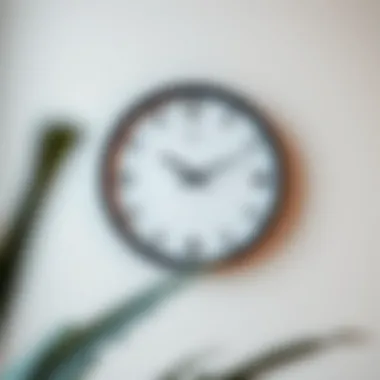
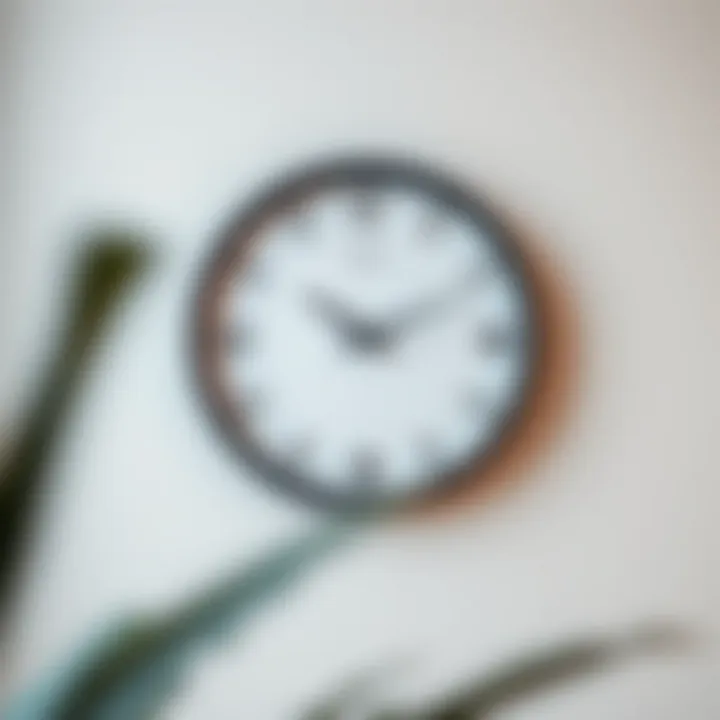
Intro
In the realm of home decor, wall clocks often get relegated to practical items that merely serve a functional purpose. However, a well-chosen wall clock is much more than just a timekeeper; it can be the centerpiece of a room, showcasing personal taste and complementing the overall design. From modern designs with sleek finishes to vintage pieces that whisper stories of the past, the options are vast, reflecting the unique character of a space.
This article embarks on a journey through the landscape of wall clocks to help homeowners and decorators alike navigate the intricacies of selecting the perfect timepiece. By examining various styles such as modern, vintage, and minimalist, we peel back the layers that contribute to the allure and functionality of these decor elements.
The aim is to empower our readers, providing insights on not just aesthetics but also on material choices, clock mechanisms, and sizing, ultimately enriching living spaces with style and substance.
Furniture Design Trends
Trending Materials and Textures
The shift in design trends has heavily influenced the types of materials and textures being favored in wall clocks today. Many modern designs boast clean lines and metallic finishes, such as brushed brass or polished steel, providing a fresh, airy feel to any space. Meanwhile, tactile materials like reclaimed wood or even ceramics draw attention and offer warmth.
- Metals: Often used for their durability and sleek aesthetics.
- Wood: Adds a natural element, ideal for rustic or farmhouse styles.
- Glass: Provides transparency and a lightweight appearance.
- Textiles: Unique clocks that incorporate fabric elements or soft textures.
Exploring these materials can lead you to clocks that not only tell time but also enhance the texture and depth of the surrounding decor.
Color Palettes and Styles
When it comes to choosing a wall clock that gels well with its environment, color plays a *pivotal8 role. Designers today are embracing a range of hues from bold primary colors to subtle pastel tones, making clocks versatile accessories in home design.
- Monochrome: Black and white clocks offer a timeless elegance, fitting well into various aesthetics.
- Vibrant Colors: Brightly colored clocks can serve as statement pieces, attracting attention and injecting life into neutral palettes.
- Metallic Finishes: Gold or silver accents add sophistication and blend effortlessly in contemporary settings.
By aligning your wall clock colors with existing elements in a room such as furniture, paint, or artwork, you create a harmonious visual flow.
Practical Tips for Furniture Selection
Assessing Space and Functionality
Before selecting a wall clock, it’s crucial to consider the available space. The size and placement of your clock should be proportionate to the walls and furniture around it. A large, ornate clock can dominate a small room, while a compact design might get lost in a spacious area.
Consider functionality—will the clock be a focal point or a subtle accessory? Both scenarios will call for different sizes and placements:
- Large Wall Clocks: Ideal for making a statement in grand living spaces or open floor plans.
- Small Clocks: Perfect for tight spots, like above a doorframe or in a cozy nook.
Balancing Aesthetics with Comfort
Finding the right balance between aesthetics and comfort is essential. Your wall clock should not only look good but also align with your lifestyle. For instance, a clock with a loud ticking sound may be less desirable in a tranquil bedroom, while a vintage clock might evoke nostalgia without compromising comfort in a family room.
In summary, understanding how wall clocks can fit into the broader spectrum of your home's design can pave the way for more informed and thoughtful choices. By paying attention to current trends in materials and colors while considering space and function, the right clock can enhance not just the walls, but the very essence of your home.
Preface to Wall Clocks
When it comes to interior design, wall clocks often don’t receive the limelight they deserve. These functional artifacts not only serve the purpose of telling time but can also be stunning focal points that enhance the overall aesthetic of a room. Just as a well-placed painting can change the atmosphere of a space, a thoughtfully chosen wall clock can add character, charm, and sophistication.
In this article, we will explore the multitude of reasons why wall clocks should be considered integral elements of home decor rather than mere timekeeping devices. Understanding their significance allows homeowners and designers to make informed choices, ensuring their selections are not just practical, but also resonate with the intended style of their living spaces.
The Role of Wall Clocks in Interior Design
Wall clocks can act as statements in a room. Often overlooked, they play a crucial role in the overall design scheme. A vintage wall clock in a rustic kitchen sets a different tone compared to a sleek, modern timepiece in a minimalist living room.
- Focal Points: A large, striking clock can draw the eye, anchoring the decor around it. Think of a grand clock in a hallway that effortlessly guides attention towards the artwork adorning the walls.
- Personal Style: Wall clocks come in a diverse range of styles, from ornate grandfather clocks to abstract designs. This variety allows homeowners to express personal taste and enhance their unique style.
- Cohesion: They contribute to the flow of a space. A well-chosen wall clock can unify various elements, tying color palettes together and maintaining a consistent theme.
Ultimately, wall clocks are more than just time pieces; they reflect the personality of the home and its inhabitants, wrapping functionality in a layer of visual appeal.
Why Choose a Wall Clock?
Selecting a wall clock goes beyond just functionality. Here’s why incorporating a wall clock into your decor should be a priority:
- Time Management: In an age of distractions, having a visible clock can assist in managing time effectively, especially in workspaces or kitchens.
- Design Enhancer: As previously mentioned, these clocks serve as stylish accessories. A rustic clock can add warmth, while a bold, modern clock can lend an edge to a cold, minimalistic space.
- Variety of Options: There’s a vast array of materials and designs to choose from—wood, metal, or glass, each bringing its unique flair.
- Conversation Starter: A unique wall clock can provide a talking point when hosting guests.
Choosing a wall clock means embracing the duality of form and function. When the design complements your living space, it becomes a seamless extension of your home, contributing depth and character.
Functionality Versus Aesthetics
When it comes to selecting wall clocks for your home, the balance between functionality and aesthetics plays a pivotal role in the decision-making process. A wall clock is much more than just a timekeeping device; it serves as a vital element of interior design that can enhance the overall character of a space. Striking this balance ensures that a wall clock complements the visual appeal of your environment while also serving its primary purpose of telling time accurately. It's crucial to consider how each element harmonizes with your existing decor, as well as how it fits into your daily routines and needs.
Understanding Clock Mechanisms
The mechanism of a clock defines how it operates, and there are three primary types to consider: quartz, mechanical, and digital. Each type has its own distinct contributions, characteristics, and charm.
Quartz Mechanisms
Quartz mechanisms are perhaps the most prevalent choice among modern clocks. Powered by a battery, these clocks utilize a small quartz crystal that vibrates at a consistent frequency, ensuring precise timekeeping. A major characteristic of quartz mechanisms is their affordability and reliability; they require minimal maintenance and are readily available in various styles.
One unique feature of quartz clocks is their silent sweep movement, which allows the second hand to move smoothly rather than in a tick-tock fashion. This can be quite appealing for those who prefer a quiet environment, particularly in bedrooms or offices. However, the downside is that quartz mechanisms might lack the nuanced craftsmanship that some traditionalists appreciate in mechanical clocks.
Mechanical Mechanisms
Mechanical mechanisms bring a distinct aura of elegance and craftsmanship that many find irresistible. Typically powered by a winding system—either manual or automatic—these clocks boast intricate gears and escapements that exemplify the art of clockmaking. The hallmark of mechanical clocks is their longevity; with proper care, they can last for generations.
A standout feature of mechanical clocks is the soothing sound of the ticking gears, which can create an endearing presence in any room. However, they require regular winding and maintenance, making them somewhat less convenient than their quartz counterparts. Nonetheless, for those who appreciate the art of horology, mechanical clocks represent a timeless investment.
Digital Options
Digital clocks stand apart with their modern capabilities, offering both time and additional features such as alarms, calendars, and even ambient temperature displays. The standout characteristic here is their clarity; the time is displayed prominently, making it easy to read at a glance.
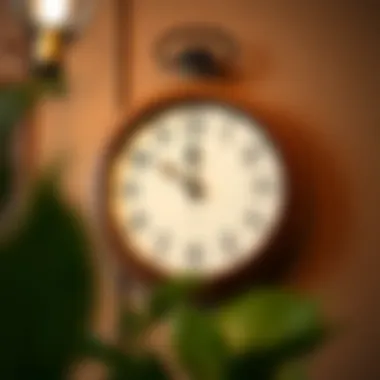
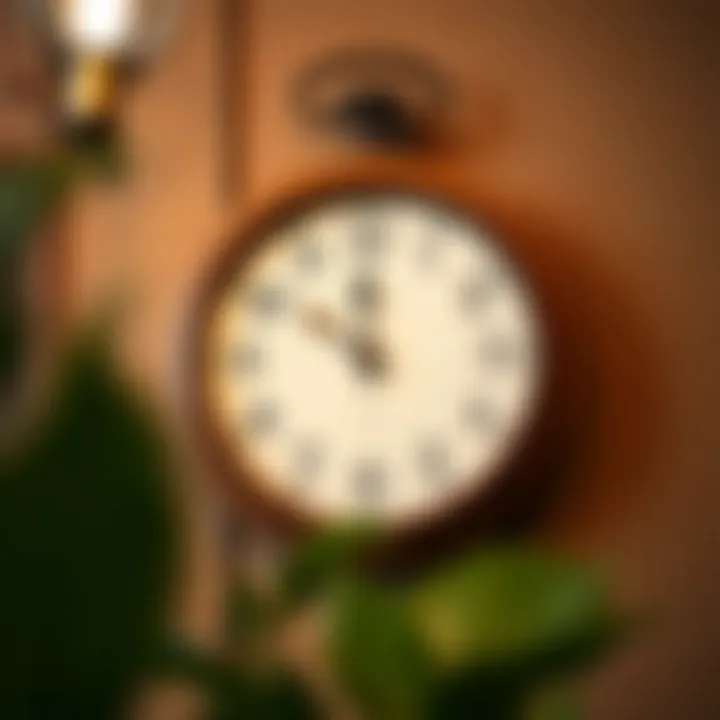
Digital clocks also embrace a blend of aesthetics and functionality with various sleek designs available. Many can even be synchronized with smart home systems, allowing for seamless integration into a high-tech living space. The downside? Some may argue that digital clocks can lack the aesthetic warmth and charm that mechanical or quartz options provide, making them feel more like appliances rather than decorative elements.
Balancing Form and Function
Striking the right balance between form and function can be the key to choosing the perfect wall clock. A stunning design might catch your eye, but if it doesn’t serve its purpose well, it can end up as just another decorative item collecting dust. Practicality is crucial; you should think about where you’re placing the clock and how frequently you will check the time.
Moreover, consider how the clock fits within the overall scope of your interior design. Is it coinciding with your color scheme? Does it clash with surrounding furniture? Being mindful of these aspects will help you find that sweet spot where beauty meets utility. Having a clock that looks great on the wall while ensuring you're always on time can elevate both your decor and daily routine.
Types of Wall Clocks
When it comes to accentuating your home's aesthetic while keeping track of time, the types of wall clocks can make all the difference. With a myriad of styles and designs to choose from, each type serves a distinct purpose that encompasses both functionality and aesthetics. Understanding these different categories allows homeowners and designers to select a clock that not only fits their style but also complements the existing decor and lifestyle. Here, we’ll delve into the intricacies of classic, modern, and themed wall clocks, highlighting their unique characteristics and benefits.
Classic Wall Clocks
Classic wall clocks evoke a sense of nostalgia and tradition. These timepieces often serve as conversation starters and can infuse warmth into any space. They come in various forms, but two standout categories are grandfather clocks and antique styles.
Grandfather Clocks
Grandfather clocks represent a grand tradition in timekeeping, known for their tall, freestanding form. Their striking presence adds a dramatic flair to residential spaces. The key characteristic of grandfather clocks is their mechanical movement, which requires winding.
This unique feature not only showcases craftsmanship but also imparts a sense of authenticity. A grandfather clock often becomes a family heirloom, passed down through generations, making it a popular choice for those looking to add value and legacy to their homes. However, it’s worth noting that they can be quite large, so they might not fit well into every room without a bit of spatial consideration.
Antique Styles
Antique style clocks blend aesthetics with history, often featuring ornate details that hark back to a different era. These clocks can range from simple designs to more elaborate pieces adorned with intricate carvings. Their timeless charm often makes them a beneficial addition to eclectic or vintage-inspired spaces.
One unique feature of antique clocks is their ability to tell stories; each scratch and imperfection can narrate a tale of its past. However, these clocks often require regular maintenance to keep them functioning, and sourcing replacement parts can be more challenging compared to modern options. They do have the potential to elevate the décor, but owners should be prepared for the added effort in upkeep.
Modern Wall Clocks
As styles have shifted over the years, modern wall clocks have emerged, valued for their minimalism and sleek innovations. These clocks cater to those who prefer a clean, uncomplicated design in their homes.
Minimalist Designs
Minimalist wall clocks emphasize simplicity and function, often featuring clean lines and understated colors. They are ideal for modern or transitional spaces, offering a contemporary look that doesn’t overwhelm the senses. The unique feature of these clocks is their ability to integrate seamlessly into various design themes without being obtrusive.
This makes them a beneficial choice for open-concept living areas where you want to uphold a sense of space rather than overcrowding it with decor. Yet, sometimes, their simplicity can run the risk of blending too much into the background, so choosing one with a bit of personality can mitigate that risk.
Sleek Innovations
Sleek innovations dive into the realm of technology, offering smart clocks that often connect to your smartphone or home systems, providing not just the time, but also options for alarms, temperature readings, and more. Their key characteristic is the integration of technology, which makes them a dynamic choice for tech-savvy homeowners.
With their modern designs, sleek clocks can serve as statement pieces while also being highly functional. However, their reliance on tech means that they may require more frequent updates or replacements compared to traditional clocks.
Themed and Decorative Clocks
Themed and decorative clocks allow for self-expression through timekeeping. They often incorporate artistic elements and fun themes, making them perfect for showcasing personal style or enhancing specific decor choices.
Artistic Clocks
Artistic clocks break the mold of conventional timepieces by serving as both functional clock and intricate art piece. They are often hand-crafted and can feature bold designs or unique materials. One of the key characteristics is that they bring a sense of creativity and vibrancy to a space, making them a popular choice in artistically inclined homes.
However, it's essential to pick one that aligns with your overall decor, as not every artistic design will mesh well with certain aesthetics. Their advantage lies in their ability to spark creativity; however, some might find them distracting if they are too bold or intricate.
Novelty Styles
Novelty clocks capture whimsy and playful spirit. Designed to fit specific themes—like sports or music—they serve to inject life into otherwise mundane wall decor. This type can be a great conversation starter and adds a personal touch. Their key characteristic is often humor or fun, making them a delightful choice for family rooms or creative spaces.
However, while they might be fun and charming, their thematic limitation could restrict their appeal in more formal settings. Thus, finding the right balance is key in making a selection that caters to both functionality and your aesthetic sensibilities.
In summary, understanding the types of wall clocks available can greatly enhance your ability to select a piece that resonates with your personal style while fulfilling the practical need to keep time. From classic to modern to whimsical designs, there's a clock for every home and taste.
Materials Used in Wall Clocks
When choosing a wall clock, the materials used are just as significant as the design and functionality. They not only determine the durability and maintenance of the clock but also shape its overall aesthetic. Homeowners and designers alike should consider how different materials complement existing decor and contribute to the atmosphere of a space.
Wooden Wall Clocks
Wooden wall clocks offer warmth and charm that can seamlessly integrate with various interior styles. The choice of wood can greatly influence the clock’s personality. For instance, oak provides resilience and rustic elegance, while bamboo lends a touch of modernity.
- Benefits of Wooden Clocks:
- Natural Insulation: Wood is a great insulator, which helps in maintaining the clock's internal mechanisms.
- Eco-Friendly: Sustainably sourced wood can make a luxurious statement without harming the environment.
- Versatile Finish Options: Stains can be applied to enhance or alter the natural color, allowing for personalization.
While wooden clocks often require more maintenance, such as regular polishing, the payoff in character is well worth the effort. Many people find these clocks to be timeless pieces that can span generations.
Metal and Glass Clocks
Metal and glass clocks epitomize sophistication and modern design. The sleek lines and reflective surfaces make them ideal for contemporary spaces. They can evoke a sense of grandeur without overwhelming other decorative elements.
- Benefits of Metal and Glass Clocks:
- Durability: Metal can withstand the test of time, and glass adds an element of elegance while remaining easy to clean.
- Variety of Styles: From industrial to elegant vintage looks, metal and glass options cater to varying tastes.
- Light Play: Glass can refract light in interesting ways, making the clock an interesting focal point in the room.
These types of clocks can be a bit pricier, and often, the craftsmanship plays a significant role in their pricing. Nonetheless, their beauty and durability can justify the investment for many homeowners.
Plastic and Eco-friendly Options
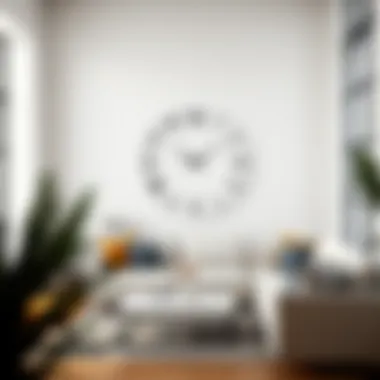

Plastic clocks, especially if made from recycled materials, represent a shift towards sustainability in design. They're lightweight and often more affordable, making them suitable for casual settings like kids' rooms or outdoor spaces.
- Benefits of Plastic and Eco-friendly Clocks:
- Affordability: They tend to be cost-effective, accommodating those on a budget.
- Variety of Colors and Designs: Plastic allows for bright colors and creative shapes that can align with any motif.
- Lightweight: Easy to hang, move or transport, they add practicality to their aesthetic appeal.
While plastic could seem less luxurious compared to wood or metal, the growing trend for eco-friendly materials is transforming perceptions. In addition to being functional, these clocks can make a statement about environmental consciousness without sacrificing style.
"Choosing the right material can elevate a simple clock into a conversation starter or a cherished heirloom."
Design Considerations
When it comes to wall clocks, there’s more at play than simply marking the passage of time. Design considerations play a crucial role in ensuring that a wall clock not only fulfills its functional purpose but also enhances the overall aesthetic of a room. The impact of a well-chosen clock extends far beyond telling time; it can influence the mood of a space, harmonize with existing decor, and create a sense of balance and style. Therefore, understanding a few key facets of design will lead to better decisions when selecting the right clock for your home.
Color Coordination
Color coordination isn’t just about matching colors; it’s about creating a cohesive look that ties a room together. Choosing a wall clock involves considering not only the clock's color but also how it relates to other elements of the space. Warm hues can create a cozy atmosphere, while cool tones often lend a modern, airy vibe.
- Complementary Colors: These are colors opposite each other on the color wheel. Think blue with orange or red with green. Using these in a clock can make it pop against a neutral wall.
- Analogous Colors: Found next to each other on the color wheel, such as blue, blue-green, and green, these create harmony. This works well for a more subtle yet visually appealing effect.
- Monochromatic Schemes: A single color in various shades can provide sophistication and simplicity, perfect for minimalist designs.
Size and Scale
The size of a wall clock is as vital as its design. An oversized clock can be a striking focal point in a spacious living area, while a smaller clock might suit cozy nooks or sections of a room that require balance rather than boldness.
- Measure Your Space: A common pitfall is purchasing a clock that speaks louder than the room itself or one that fades into the backdrop. Look at the wall where the clock will hang and assess how much space is available.
- Statement Pieces: A large, artistic clock can dominate a wall, serving as a conversation starter and adding character. But beware: too large and it can overshadow the intended design elements in the space.
Style Compatibility
When selecting a wall clock, one must consider how the clock's style resonates with the overall theme of the room. Different styles serve various functions and can either bolster or clash with existing decor.
Modern
Modern style often leans towards clean lines, minimalistic designs, and functional aesthetic. A modern clock can add sophistication and a sense of clarity to a space. Notably, the most appealing aspect of modern design is the focus on simplicity, which usually lends itself well to versatility. For a living room styled with contemporary furniture, a sleek, geometric clock could effortlessly tie the room together.
- Key Characteristic: The absence of excessive embellishment makes modern clocks excellent for achieving a streamlined, uncluttered look.
- Unique Feature: Many modern designs employ materials like metal or acrylic, allowing for unique finishes and easy maintenance, contributing to their appeal.
Traditional
Unlike its modern counterpart, traditional design often incorporates ornate details, rich materials, and a classic charm that transcends time. A traditional clock reminds us of craftsmanship and history, easily complementing classic decor.
- Key Characteristic: Detailed craftsmanship involved in traditional clocks makes them a symbol of lasting quality, often with intricate woodwork or vintage styling.
- Unique Feature: Many traditional pieces come with rich, deep colors that can warm up a room, making them a wise choice for spaces decorated in vintage or regal themes.
Eclectic
Eclectic styles blend various elements from different time periods or design philosophies, creating a unique and personal space. An eclectic wall clock may combine textures, patterns, and colors that don’t traditionally go together but offer charm and individuality.
- Key Characteristic: The beauty of eclectic clocks lies in their ability to reflect the homeowner's personality and taste, making them truly one-of-a-kind pieces.
- Unique Feature: These clocks may possess unexpected features, like mismatched numbers or unconventional shapes, offering flexibility and creativity in design.
Ultimately, design considerations like color, size, and style integration boil down to enhancing the spaces we inhabit daily. By selecting a wall clock aligned with these factors, you can achieve an effective blend of function and flair that aligns with your vision.
Popular Brands and Manufacturers
When it comes to wall clocks, the brand behind the design can significantly influence not only aesthetics but also quality, durability, and features. Understanding which manufacturers have earned their stripes in the market can guide homeowners, interior designers, and decorators in making informed choices. A well-made clock can be the backbone of room decor, striking the perfect balance between functionality and style. Choosing a clock from a reputable brand can often mean investing in superior craftsmanship and reliable timekeeping.
Renowned Clockmakers
There are several clockmakers with a longstanding reputation for excellence in the crafting of wall clocks. Brands like Howard Miller, Seiko, and Bulova have been household names for years. These manufacturers are recognized for a few things:
- Quality Craftsmanship: Each brand often employs skilled artisans and innovative techniques, leading to precision in their clock mechanisms.
- Diverse Offerings: Renowned clockmakers tend to provide a variety of styles ranging from classic, elegant designs to modern minimalist pieces, thus catering to a wide array of tastes.
- Longevity: These brands usually have a proven track record of producing clocks that not only look great but also continue to function well for years, becoming a staple in homes.
For instance, Howard Miller has crafted clocks that have adorned homes for generations. Their grandfather and wall clocks are often seen as statement pieces that add a touch of class to any room. On the other hand, Seiko is known for incorporating advanced technology even into their traditional clock designs, making timekeeping not just stylish but precise.
Emerging Brands
In contrast to the established giants, emerging brands are making waves in the wall clock sector. Companies like Tockr and Modernist Clock Company are gaining recognition for their innovative designs and fresh approaches. Look out for what they bring to the table:
- Unique Designs: Emerging brands are often unafraid to experiment with unconventional shapes or materials, reflecting modern trends and tastes. For example, Tockr mixes nostalgia with a current twist in their designs, attracting a younger demographic.
- Sustainable Practices: Many of these newer companies emphasize eco-friendly practices, using sustainable materials and methods in their production. Conscious consumers appreciate brands like Modernist Clock Company, which aims to create products that have minimal environmental impact.
- Affordability: Emerging brands typically offer competitive pricing, making stylish wall clocks more accessible without sacrificing quality.
In summary, staying abreast of both established and new brands allows aficionados and casual interest holders alike to navigate the world of wall clocks effectively. Choosing a clock doesn't simply come down to looks; understanding the manufacturer can mean the difference between a fleeting trend and a timeless piece.
Installation and Maintenance
Wall clocks are more than just timekeepers; they are essential elements of your home decor. Understanding the importance of proper installation and maintenance cannot be overstated. Poorly hung clocks can not only mar the aesthetics of a room but also affect their functionality and longevity. In this section, we'll look at how to install your wall clock correctly and keep it ticking smoothly over time.
Proper Hanging Techniques
Hanging a clock may seem straightforward, but there are key considerations to ensure it is both functional and visually appealing.
- Select the Right Height: A common mistake is to hang clocks too high or too low. Ideally, the center of the clock should be at eye level. This height lets you check the time easily without straining your neck.
- Use Quality Hardware: Depending on the weight of your clock, it’s crucial to use the right hanging hardware. For heavier clocks, use wall anchors or screws instead of simple nails. This prevents the clock from falling and potentially breaking or causing injury.
- Consider Placement: Think about the surrounding decor. A clock can serve as a centerpiece, so it should not compete with other wall art. Directly across from a sofa or in a hallway where people pass frequently is often ideal.
- Level the Clock: Use a level to ensure your clock is straight. There’s nothing more distracting than a clock that’s tilted to one side, drawing attention away from its beauty.
Regular Maintenance Tips
To keep your wall clock looking sharp and working effectively, some maintenance tips come in handy.
- Dust Regularly: Accumulation of dust can affect the clock’s movement. Use a soft cloth to wipe it down gently once a week.
- Check Battery Life: For quartz clocks, keep an eye on the battery. It's easy to forget until you notice the clock has stopped. Change the battery at least once a year to keep time accurate.
- Inspect Mechanics: If your clock is ticking loudly or irregularly, it may need oiling. A drop of clock oil on the movement can solve this issue. Just a tiny bit can go a long way, ensuring that it runs smoothly and quietly.
"A well-maintained clock does more than tell time; it enhances the overall ambiance of your space."


- Watch for Temperature Extremes: Wall clocks can be sensitive to humidity and temperature. Avoid placing them near heat vents or in direct sunlight, which can warp materials or fade colors over time.
By following these hanging techniques and maintenance tips, you can guarantee that your wall clock remains an enhancement to your home rather than a hassle. Proper care and placement can transform a simple timepiece into a timeless piece of art.
Case Studies of Successful Implementations
When it comes to choosing wall clocks for both residential and commercial spaces, there’s no substitute for real-world examples. Case studies reveal how certain designs not only tell time but also enhance the overall atmosphere of a room. By examining these successful implementations, homeowners, designers, and decorators can glean insights on what works and how to create spaces that evoke the desired ambiance.
Residential Spaces
Let’s start by exploring residential implementations. Picture a sunlit dining room dressed in soft pastels. The focal point is a large, vintage-style wall clock that resonates with the charming decor of the space. This clock not only adds functionality but also injects character. The choice of a classic Roman numeral clock complements the traditional wooden dining table, giving the room an inviting warmth.
In addition to aesthetics, think about how the size and placement of wall clocks can impact flow. In a smaller kitchen, a sleek, minimalist clock might keep the visual clutter to a minimum while maintaining an air of sophistication. A larger wall clock, however, can provide a striking element in an expansive living room.
"In interior design, every piece has a role to play. A wall clock can be both functional and a conversation starter."
The color palette of a home also plays a vital role in clock selection. A bright yellow clock can become a unexpected pop of color on a neutral wall, creating a lively contrast that draws the eye. By integrating wall clocks thoughtfully into residential spaces, homeowners can strike a balance between functionality and style.
Commercial Establishments
Moving beyond the confines of home, commercial spaces also utilize wall clocks in their design strategies. For example, the lobby of a modern office building might showcase a large, digital clock that combines both time-telling and branding opportunities. Not only does it display the time but it could also cycle through the company’s key messages or quotes, making it a dual-purpose feature.
In restaurants, themed wall clocks can set the mood. An artisan pizza place might feature a clock made from repurposed kitchen materials, reflecting its sustainable ethos. On the other hand, a chic café might opt for a vintage metallic wall clock to enhance its rustic charm.
Consideration of brand identity in these cases is significant. A tech startup might employ a sleek, contemporary clock that hints at innovation and forward-thinking while a local bookstore may prefer a cozy, literary-themed clock featuring classic literature quotes. The choice undoubtedly creates an atmosphere that resonates with the patron’s expectations, enhancing their overall experience.
Whether in homes or businesses, these case studies reveal that the integration of wall clocks shouldn’t be an afterthought. Instead, it should be a deliberate choice that harmonizes with individual style and the ambiance of the environment.
Impact of Wall Clocks on Room Ambiance
Wall clocks play a vital role in the overall vibe of a room. They do much more than just tell time; they can add character, enhance style, and even change how a space feels. When choosing a wall clock, one must think about how it fits into not just the design but the mood of the entire area. The right clock can introduce warmth, add sophistication, or maybe make a bold statement, depending on its design and placement.
A thoughtfully-picked wall clock can act as a conversation starter, bridging the gap between functionality and emotional expression. As we delve deeper, let’s explore how wall clocks can create focal points and enhance atmosphere through design.
Creating Focal Points
A wall clock can serve as an eye-catching centerpiece in any room. It draws the gaze and helps define parts of the space. For instance, a large, vintage grandfather clock in a cozy living room can instantly captivate attention, establishing a point of interest. When placed strategically, in line with other decor elements like artwork or shelving, a clock can unify the room’s aesthetic.
Consider this when deciding on your clock:
- Size: A dominating clock can command a wall, turning it into a statement. Conversely, smaller clocks may serve to subtly complement the decor without stealing the show.
- Location: Hang your clock at eye level. This not only makes it easy to read but also enhances its effectiveness as a focal piece.
- Contrast: A dark wood clock on a light wall can pop beautifully, while a similar tone might blend too much and lose its striking effect.
It’s all about alignment within the space. A wall clock, when accurately placed, has the potential to balance out other decor elements and guide the viewer's eyes around the room.
Enhancing Atmosphere Through Design
Wall clocks also significantly affect the atmosphere of a room. A sleek minimalist clock can induce a calming effect, especially in a tranquil setting like a bedroom or meditation space. On the other hand, a bold, colorful clock can inject energy into a dining area or playroom.
Here’s how design can lift a room’s spirit:
- Color Schemes: Opt for colors that match or contrast with existing elements. A vibrant clock can brighten a dull room, while softer hues work well in spaces like libraries or reading corners.
- Material Choices: A metal clock gives an industrial feel, whereas a wooden clock may bring warmth. Choose based on the energy you wish to convey.
- Style Alignment: Ensure that the clock style matches the room theme. A rustic clock might feel out of place in a contemporary space, so consideration is key.
"The real victory lies in finding that perfect balance between form and function when choosing a wall clock for your home."
Ultimately, understanding the impact wall clocks can make will guide homeowners and designers alike in creating spaces that not only mark time but elevate the entire environment.
Trends in Wall Clock Design
Keeping your finger on the pulse of wall clock design is essential, especially in an age where both functionality and aesthetics are at the forefront of home decor. Wall clocks not only fulfill a practical purpose by displaying time, but they also serve as expressive pieces that can transform a room's vibe. With the continuous evolution of interior design trends, homeowners and designers must stay informed about what's in vogue to choose clocks that don't just hang on the wall but resonate with the overall theme of the space.
Smart Clocks and Technology Integration
In our tech-driven world, it’s no surprise that smart clocks have started to carve out a niche within home decor. These modern wonders go beyond the traditional ticking sound, integrating features such as
- Wi-Fi connectivity
- Bluetooth capabilities
- Alexa or Google Home integration
Imagine a wall clock that syncs with your smartphone, adjusts its time automatically across time zones, and even reminds you of appointments. They bring a whole new dimension to timekeeping, merging utility and design in a magnificent way.
Moreover, some smart clocks are replete with LED displays that can transform according to the light in the room, making them not just functional but visually stunning as well. They also allow customization of colors and designs through software applications, creating a truly personalized atmosphere. However, while embracing technology, it’s crucial to consider usability. A clock that’s too complex may end up being more of a headache than a helpful tool. Aim for models that effectively balance digital innovation with ease of use, giving a nod to the classic charm of traditional wall clocks while reaping the benefits of modern advancements.
Sustainable and Eco-Friendly Designs
The trend towards sustainability can't be overlooked, especially in today’s environmentally conscious landscape. When choosing wall clocks, considering eco-friendly designs is not just a nod to good practice, it’s a significant contribution to preserving our planet. Many designers are now utilizing sustainable materials like bamboo or reclaimed wood, which not only cuts down on waste but also adds a unique rustic touch to each piece.
In terms of mechanics, opting for clocks that incorporate solar-powered or battery-operated mechanisms can substantially reduce your carbon footprint. Clocks featuring these environmentally friendly options often come with stylish and contemporary designs that appeal to a broad range of tastes.
"In a world increasingly defined by fleeting trends, choosing sustainable design is akin to investing in a future that values both function and environmental stewardship."
The appeal of eco-friendly clocks extends even further; opting for these designs often means supporting smaller, local artisans who prioritize ethical production methods over mass manufacturing. By doing so, homeowners not only beautify their spaces but also foster community-based economies and sustainable practices.
By embracing the trends of smart technology and eco-conscious designs, you elevate the aesthetic and functional appeal of your home. Ensuring that your choices in wall clocks reflect these trends can create a perfect harmony of style and substance in your living environment.
Culmination
In the realm of interior design, the choice of wall clocks transcends mere functionality, capturing the essence of both timekeeping and aesthetic value. The importance of understanding how to select wall clocks is paramount, as these timepieces serve not just as tools to tell time, but as integral components that can enhance the ambiance of a room.
When reflecting on the elements discussed throughout this article, consider that wall clocks can define a space's style narrative. Whether a buyer is leaning towards modern minimalism or embracing a vintage twist, the wall clock's design plays a critical role. It’s vital to assess several factors such as material selection, design consistency with existing decor, size relevance within the spatial context, and the clock's overall mechanism, to ensure a cohesive visual statement.
Moreover, wall clocks influence the mood of a room. A sleek, streamlined design can foster a more industrial vibe, while a rustic wooden clock can evoke warmth and nostalgia. As decor trends evolve, awareness of emerging styles and technologies – like smart clocks – fosters informed decisions that marry tradition with innovation.
Ultimately, selecting the right wall clock is not just about telling the time nor is it just about picking a piece that complements a color scheme. It's about fostering an environment that speaks to the homeowner's identity and enhances the functionality of their space. Thus, armed with the right knowledge and considerations, one can transform a simple wall clock into a striking centerpiece that resonates with both form and function.
Key Takeaways for Selecting Wall Clocks
- Understand Your Style: Consider the overall theme of your home. Whether it’s modern, rustic, or eclectic, choose a wall clock that resonates with that theme.
- Material Matters: Different materials convey different vibes. Wooden clocks add warmth, metals provide a modern edge, and glass often lends an airy feel.
- Size and Scale: Ensure that the clock's size is appropriate for the wall space. A massive clock can overwhelm a small room, while a tiny clock might get lost on a large wall.
- Functionality vs. Aesthetics: Balance the practical function of timekeeping with aesthetic appeal. Choose mechanisms that suit your lifestyle, whether it's quartz accuracy or the charm of mechanical clocks.
- Casual Observations: Sometimes, the best selections come from simply observing how pieces interact within the space. Take a moment to envision how a clock transforms the feel of your room before making a decision.



